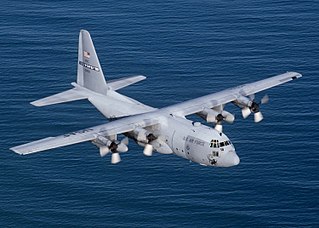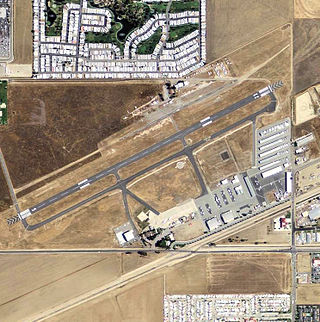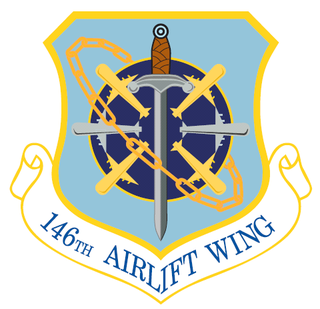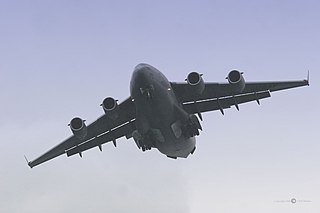
The Lockheed C-130 Hercules is an American four-engine turboprop military transport aircraft designed and built by Lockheed. Capable of using unprepared runways for takeoffs and landings, the C-130 was originally designed as a troop, medevac, and cargo transport aircraft. The versatile airframe has found uses in other roles, including as a gunship (AC-130), for airborne assault, search and rescue, scientific research support, weather reconnaissance, aerial refueling, maritime patrol, and aerial firefighting. It is now the main tactical airlifter for many military forces worldwide. More than 40 variants of the Hercules, including civilian versions marketed as the Lockheed L-100, operate in more than 60 nations.

Aerial firefighting, also known as waterbombing, is the use of aircraft and other aerial resources to combat wildfires. The types of aircraft used include fixed-wing aircraft and helicopters. Smokejumpers and rappellers are also classified as aerial firefighters, delivered to the fire by parachute from a variety of fixed-wing aircraft, or rappelling from helicopters. Chemicals used to fight fires may include water, water enhancers such as foams and gels, and specially formulated fire retardants such as Phos-Chek.

Conair Group Inc. of Abbotsford, British Columbia, Canada, formerly known as Conair Aviation, is a company specializing in retrofitting firefighting aircraft, maintaining customer and company-owned aircraft and aerial firefighting. Conair currently employs over 250 staff and has a fleet of aircraft that are broken down into two categories; air attack, and airtankers. Conair specializes in fire management support by providing services and products to forest protection agencies around the world. In 1996 Conair became a Canadian Air Tractor dealer for the AT-802F air tanker. A former Conair Group division; Cascade Aerospace was acquired by the IMP Group of Halifax, Nova Scotia in 2012.

Hemet-Ryan Airport is three miles (6 km) southwest of Hemet, in Riverside County, California.

The DC-10 Air Tanker is a series of American wide-body jet air tankers, which have been in service as an aerial firefighting unit since 2006. The aircraft, operated by the joint technical venture 10 Tanker Air Carrier, are converted wide-body McDonnell Douglas DC-10-30 passenger jetliners, and are primarily used to fight wildfires, typically in rural areas. The turbofan-powered aircraft carry up to 9,400 US gallons of water or fire retardant in an exterior belly-mounted tank, the contents of which can be released in eight seconds. Four air tankers are currently in operation, all DC-10-30 aircraft, with the call-signs Tanker 910, 911, 912 and 914. The original Tanker 910, a DC-10-10, was retired in 2014.
The CAL FIRE Aviation Management Program is a branch of the California Department of Forestry and Fire Protection. Due to the frequency and severity of wildfires in California, the state has elected to establish its own aerial firefighting force rather than rely solely on national resources. The Aviation Management Program is based at McClellan Airfield near Sacramento, California.

In 2002, two large airtankers – a Lockheed C-130 Hercules and a Consolidated PB4Y-2 Privateer – crashed about a month apart while performing aerial firefighting operations. These crashes prompted a review of the maintenance and use of the entire U.S. large airtanker fleet. Ultimately, the whole fleet was grounded, dramatically reducing the resources available to fight major wildfires. Both aircraft were owned by Hawkins & Powers Aviation of Greybull, Wyoming and operated under contract to the United States Forest Service (USFS). The crashes occurred in one of the worst fire seasons in the last half century, one in which 73,000 fires burned 7.2 million acres (29,000 km2) of land.

The 146th Airlift Wing is a unit of the California Air National Guard, stationed at Channel Islands Air National Guard Station, Oxnard, California. If activated to federal service, the Wing is gained by the United States Air Force Air Mobility Command.

The 153d Airlift Wing is a unit of the Wyoming Air National Guard, stationed at Cheyenne Air National Guard Base, Wyoming. If activated to federal service, the Wing is gained by the United States Air Force Air Mobility Command.

The U.S. Forest Service airtanker scandal involved a scheme, officially called the Historical Aircraft Exchange Program, in which the U.S. Forest Service would acquire retired U.S. Air Force C-130A transport aircraft and U.S. Navy P-3 anti-submarine patrol aircraft, ostensibly for use as firefighting airtankers, but which ended up with the planes' ownership being transferred illegally to private companies and the aircraft themselves being used for other purposes or even sold for a profit. The controversy resulted in two of the involved principals being sentenced to prison and a number of civil lawsuits.

The Wyoming Air National Guard (WY ANG) is the aerial militia of the State of Wyoming, United States of America. It is, along with the Wyoming Army National Guard, an element of the Wyoming National Guard.

The 115th Airlift Squadron is a unit of the California Air National Guard 146th Airlift Wing located at Channel Islands Air National Guard Station, Oxnard, California. The 115th is equipped with the C-130J Hercules.

Aero Union Corporation was an aircraft operation and maintenance company based in Chico, California, United States. It was known for operating aerial firefighting aircraft, training crews and making custom designed firefighting systems tailored to specific aircraft requirements. After years of controversies regarding the operation of the company and the safety of its aircraft, the U.S. Forest Service (USFS) canceled its contract, and the company was forced to shut down soon after.

The 747 Supertanker was one of several aerial firefighting airtankers derived from various Boeing 747 models. The aircraft were rated to carry up to 19,600 US gallons (74,000 L) of fire retardant or water. They were the largest aerial firefighting aircraft in the world.
The Fresno Air Attack Base was established in 1955 By the US Forest Service, Sierra National Forest and is located at the Fresno Yosemite International Airport. The US Forest Service leases office space to the California Department of Forestry and Fire Protection's Fresno/Kings Unit. In 1994, it was completely rebuilt to become a model modern AirTanker Base which includes a modern interagency communication/command center.

The 52d Airlift Squadron is a Regular Component United States Air Force unit. Its currently assigned to the 19th Airlift Wing at Little Rock Air Force Base, Arkansas, but is based at Peterson Air Force Base, Colorado. There, the squadron flies and maintains aircraft with the Air Force Reserve's 302d Airlift Wing.

On 31 July 2010, a Convair CV-580 Airtanker aircraft operated by Conair Aviation crashed while on a firefighting mission near Lytton, British Columbia, Canada. Both crew members, the only people on board, were killed.
Neptune Aviation Services Inc. is an aerial firefighting company based out of Missoula International Airport in Missoula, Montana. It provides aerial support and firefighting to the United States, Canada, Chile and throughout the world. Founded in 1993, Neptune Aviation is known for aerial firefighting, aviation maintenance, fixed-base operator and air charter operations.

The 145th Airlift Wing is a unit of the North Carolina Air National Guard. It is assigned to Charlotte Air National Guard Base, North Carolina and is equipped with the Boeing C-17 Globemaster III aircraft. If activated to federal service in the United States Air Force, the 145th is gained by Air Mobility Command.
White Draw Fire was a wildfire in South Dakota, United States, that started on Friday, June 29, 2012. The fire burned a total area of 14 square miles, mainly the U.S. Forest Service land. The fire did not harm any civilian population or livestock; however, a military C-130 MAFFS air tanker crashed in the Black Hills during firefighting.





















